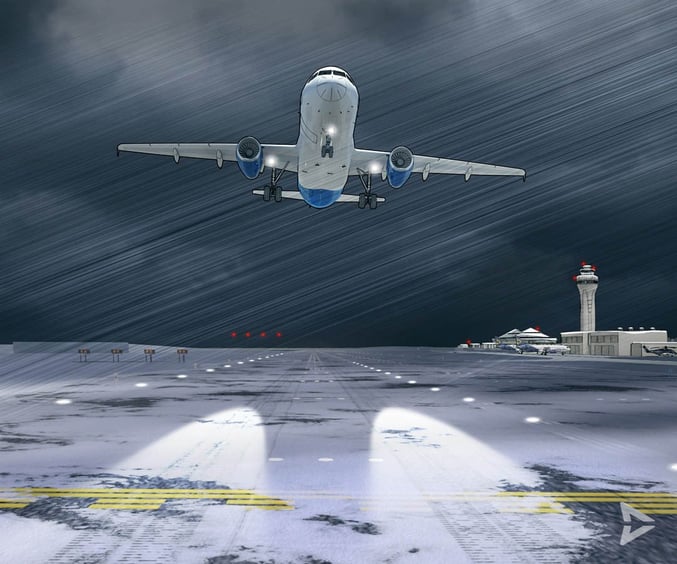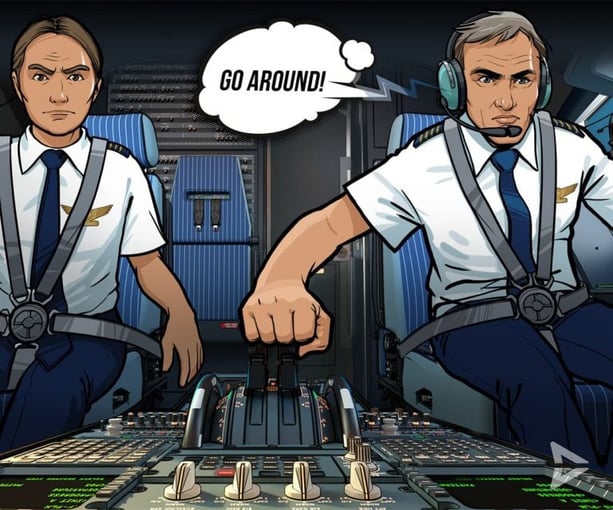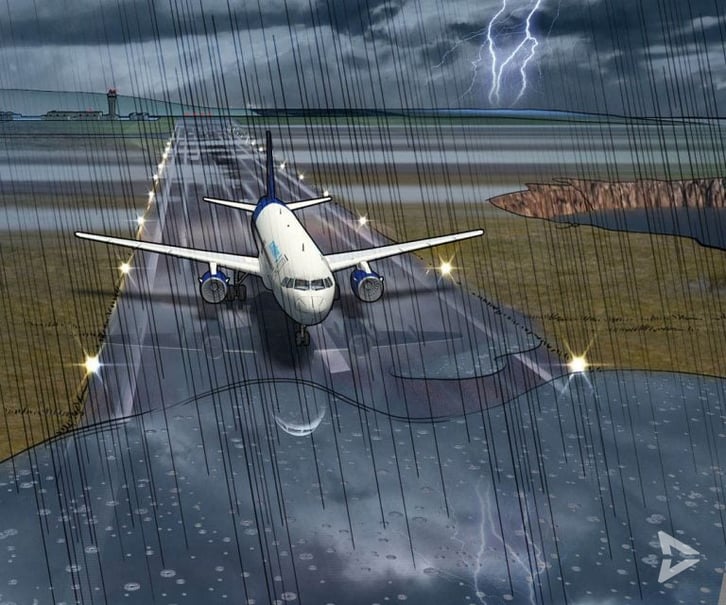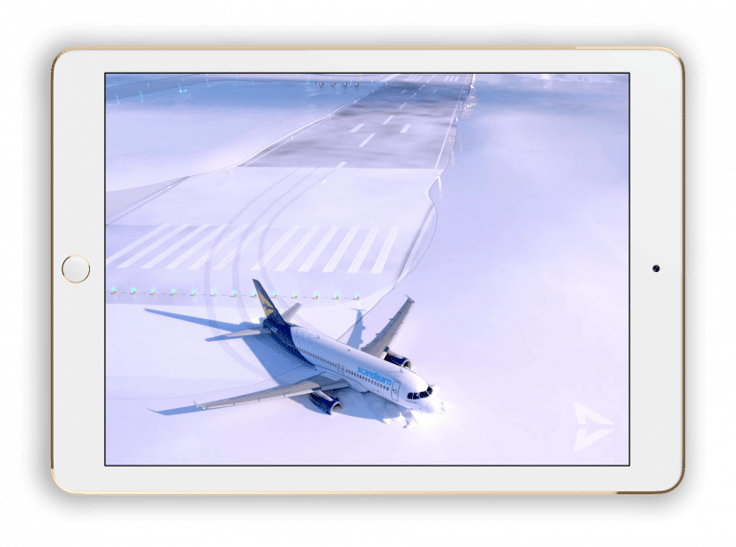During my 40-year flying career, I’ve been spared with no flight accidents. However some routes are just like any regular day, and others can be a bit more adventurous. Here are two short stories and the reason why I’m happy that the Global Reporting Format (GRF) will be introduced on November 4th, and for EU 12th of August 2021.
After arriving at the airport and checking myself in, I made my way to the briefing room and met up with the first officer. We began to discuss our schedule and to plan the four flights that we were expecting to take that day. The first one was a domestic flight, Stockholm to Gothenburg, a short 40 minutes in duration. Our second flight would take us from Stockholm to Berlin. At some point during our discussion, we checked the weather forecast as part of our planning procedure.
Weathering the storm
My early morning prediction was seemingly correct, the weather was nasty. This wasn’t going to be a walk in the park! The storm had hit Gothenburg quite badly and we would be heading into heavy snowfall as well as a very strong crosswind. Again, this wasn’t ideal but we knew how to handle the situation. We were both in agreement that we would need a lot of fuel due to the strong crosswind preventing us from landing.
Once we had finished planning our flights, we met up with the cabin crew. We briefed them about the situation before making our way to the aircraft together. It was Christmas Eve and we were expecting a busy flight. Our Boeing 737-800 was packed with almost 200 hundred passengers, all wanting to get somewhere for Christmas Day.
Due to the good work of the ground crew, the take-off from Stockholm Arlanda airport was largely uneventful. They had managed to clear the snow from the runway, making our departure somewhat easier. The flight to Gothenburg Landvetter airport was quite short and as soon as we were airborne, we took a minute to check the weather forecast for our destination.
We came to realise that the visibility wouldn’t present us with any problems, the cloud base was 500ft and overcast. The crosswind, however, was a different proposition. It was still 10 knots over the permitted limit for landing under such circumstances. We soon switched over to the Gothenburg approach and were informed that there were no problems. Aircraft had been landing throughout the entire day and there was no snow sweeping in progress.

What would you do, land or go-around?
The fact that flights had been landing all day, not only from my own airline but international flights as well was puzzling me. We decided to start the approach and hope that the wind would calm down enough for us to land safely. Before the approach, the first officer and I had already decided what our limits would be. If the wind died down then we would land, if not we would perform a go-around.
We passed 1500ft as the aircraft before us, an Embraer, landed. They reported that the conditions were very, very slippery which wasn’t great news for us. I noticed on the Navigation Display (ND) that the crosswind was still above the permitted allowance for landing. We couldn’t understand how the aircraft in front of us could land in these conditions
I had little choice other than to press the button on the thrust lever and make a go-around. Yet, immediately after doing so, I felt stupid. I was the first aircraft of the day to perform a go-around although it was the safest option
At 500ft, we broke out of the cloud. The runway looked quite bad with the snow coming in sideways due to the crosswind. We asked the tower for information regarding the wind on the ground and were informed that it was still 10 knots over the landing limit. I had little choice other than to press the button on the thrust lever and make a go-around. Yet, immediately after doing so, I felt stupid. I was the first aircraft of the day to perform a go-around although it was the safest option.

Colleagues united, aborting approach
Straight after performing a go-around, the tower made contact with us to ask our intentions. After talking to the first officer, we made the decision to go to the holding as we still had fuel for another approach. At that moment, we began to hear that other aircraft were performing a go-around too. Lufthansa made their move first, followed by the next flight in line, British Airways. They were all aborting the approach in the same way that we had. The last flight, Turkish Airlines, followed suit and ended up in the holding pattern with the rest of us.
I’ve never felt so happy that my colleagues came to the same decision as us in aborting their approach. We were the trigger, with the rest following, that forced the airport to close. They then got the snow cleared from the runway and, after a 15 minute wait, we were given permission for a new approach. The snow was causing the problems. Once that was out of the way we could handle the crosswind. All four aircraft landed safely without any further problems. After that, the airport was closed for a further three hours before we could fly back to our destination but that’s another story.
Global Reporting Format (GRF) - Embracing New Methods
Thanks to ICAO, 4th of November 2021 the new Global Reporting Format (GRF) will enter into force. The GRF is a new methodology for assessing and reporting runway surface conditions in cold and hot weather. There will be a standardised way of reporting runway surface conditions. Also, there will be a common language between all the related parties such as pilots, ATC, MET, Airport Operators, etc.
This will harmonise assessment and reporting of runway surface conditions worldwide and correspondingly improve flight crew assessment of take-off and landing performance. Scandlearn has created a highly visual GRF online training for you on this. It is the a perfect training for flight crew to gain knowledge and confidence on how to use this new reporting system. The high-quality graphics really gives an in-depth understanding and detailed panorama look of landings and take offs in both tropical and winter scenarios. It also contains great pedagogical elements that explains the procedures, and leads you through the topic. This will definitely bring clarity for international aviation and increase flight safety.
I think this is what we experienced in Gothenburg. Of course, all of us were in the land mode because it was the day before Christmas. Everyone who landed had a different way of calculating and assessing the contaminated runway surface conditions at Gothenburg. This allowed some aircraft to land, and some were not allowed to land according to company procedures. The new GRF will be a safe and unified way to calculate and assess the runway surface conditions in the future.
Also, note that the Global Reporting Format (GRF) considers water-flooded runways in hot weather conditions and not only wintery conditions.
The flight was supposed to be easy...
Here comes the second short story, set in a different environment than the Gothenburg story.
It was a nice summer day in Scandinavia, and I had a very early check-in around 4 a.m. I met with my first officer, who was newly hired with only a couple of weeks of experience. We were going to fly a charter flight to the Greek island of Skiathos. Those of you who have been there, know that the airport runway is very short, 1.600 m (5.341 ft). Our Boeing 737-800 was packed with almost 200 vacationers looking forward to starting their holiday.
I decided to take the flight due to the inexperienced first officer, and he had never landed on such a short runway. We checked the weather, and it was a lovely day CAVOK all over Europe and in Skiathos and at our alternate Thessaloniki. I was looking forward to an easy trip and then back again for a three-day leave. We met the cabin crew and briefed them on the flight, and then off we went. Everything went smoothly. We got all the passengers onboard and even departed five minutes ahead of schedule. Wonderful!
When airborne, we checked the weather at Skiathos and it was all excellent with weak northwesterly winds and CAVOK and pleasant 25 degrees Celsius in the morning. It was going to be a hot day there. I made a public announcement to the passenger informing them about our route over Europe and the beautiful weather ahead and at Skiathos.

The sky turned black
A few hours into the flight, we passed over our alternate Thessaloniki, and it was sky clear, but on the horizon, we started to see a big thunderstorm cloud coming up. We once again checked the weather at Skiathos, and it was still CAVOK. However, we could see that something was happening. We started the descent into Skiathos and was switched over to the approach.
The sky was black, and the weather radar showed a lot of red colour around the airport. The tower informed us that it seemed that the only thunderstorm in Greece was building up at our destination.
I asked the first officer to prepare and calculate the worst-case scenario of what we needed to land on that short runway. Better be prepared. According to company standards, we did not carry any extra fuel for holdings, so there was only one approach possible, and then we needed to head for the alternate, Thessaloniki. We could not wait out the bad weather.
The air traffic controller returned to us and said it had started to rain heavily, and the wind had shifted to a crosswind. At least it was not a tailwind. The first officer came back with the figure, and we could still land and have 30 m marginal to be legal. I gave the controls to the first officer for a moment while I was double-checking his calculation. The first officer did a good job. It was all correct, and we asked for permission to land.
Full reverse
I took over the controls again and was mentally preparing myself for the short landing in heavy rain. 30 m marginals were not much to go on. We were stabilised at 1000 ft and passed the runway beginning at the correct speed and altitude. I noticed a lot of water on the runway, and it was raining quite heavily. As soon as we touched down, I went into full reverse and checked that the auto-brakes were working before I took over manually.
I noticed a lot of water on the runway, and it was raining quite heavily. As soon as we touched down, I went into full reverse and checked that the auto-brakes were working before I took over manually.
After approximately 2/3 of the runway, the aircraft came to a complete stop. I guessed the passengers may not have been so happy with the hard braking. I explained to them afterwards why we needed this, due to the rain. I felt that most of them were happy when they left the aircraft and could start their vacation.
When I said goodbye to the passengers, I watched an A320 coming in for landing also from my airline. They had the same conditions, and I saw them land on the runway. However, they did not stop at 2/3 of the runway. They continued down the runway, and I started to be worry that they would not make it, but luckily a few minutes later, they taxied into the ramp.
I had some time before my flight was going to depart, so I talked to the flight crew at the A320 and found out they had used most of the runway before the aircraft came to a complete stop. They said it was very unpleasant.
It was interesting to see how the same conditions on the runway could create such a different result. There were only 10 minutes between our flights.


